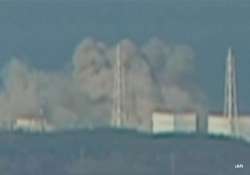Blast Near Nuclear Plant, Walls Fall, Smoke Pours
Sendai, Japan, March 12 : An explosion at a nuclear power station tore down the walls of one building Saturday as smoke poured out and Japanese officials said they feared the reactor could melt down

Sendai, Japan, March 12 : An explosion at a nuclear power station tore down the walls of one building Saturday as smoke poured out and Japanese officials said they feared the reactor could melt down following the failure of its cooling system in a powerful earthquake and tsunami.
It was not clear if the damaged building housed the reactor. Tokyo Power Electric Co., the utility that runs the Fukushima Dai-ichi plant, said four workers were injured but details were not immediately available.
Footage on Japanese TV showed that the walls of one building had crumbled, leaving only a skeletal metal frame standing. Puffs of smoke were spewing out of the plant.
"We are now trying to analyze what is behind the explosion," said government spokesman Yukio Edano, stressing that people should quickly evacuate a six-mile (10-kilometer) radius. "We ask everyone to take action to secure safety."
The trouble began at the plant's Unit 1 after Friday's massive 8.9-magnitude earthquake and the tsunami it spawned knocked out power there. The disaster has killed hundreds of people and devastated the country's northeastern coast, where rescuers began slowly arriving Saturday.
The toll of destruction was still not known more than 24 hours after the quake since washed-out roads and shut airports have hindered access to the area. An untold number of bodies were believed to be buried in the rubble and debris.
The official death toll stood at 413, while 784 people were missing and 1,128 injured. In addition, police said between 200 and 300 bodies were found along the coast in Sendai, the biggest city in the area near the quake's epicenter. Local media reports said at least 1,300 people may have been killed.
Adding to worries was the fate of nuclear power plants in the region. Japan has declared states of emergency for five nuclear reactors at two power plants after the units lost cooling ability.
The most troubled one is facing meltdown, officials have said.
Pressure has been building up in the reactor -- it's now twice the normal level -- and Japan's Nuclear and Industrial Safety Agency told reporters Saturday that the plant was venting "radioactive vapors." Officials said they were measuring radiation levels in the area.
The reactor in trouble has already leaked some radiation: Operators have detected eight times the normal radiation levels outside the facility and 1,000 times normal inside Unit 1's control room.
Wind in the region is weak and headed northeast, out to sea, according to the Meteorological Agency.
Ryohei Shiomi, an official with Japan's nuclear safety commission, said that even if there was a meltdown, it wouldn't affect people outside a six-mile (10-kilometer) radius -- an assertion that might need revising if the situation deteriorates. Most of the 51,000 residents living within the danger area had been evacuated, he said. AP
It was not clear if the damaged building housed the reactor. Tokyo Power Electric Co., the utility that runs the Fukushima Dai-ichi plant, said four workers were injured but details were not immediately available.
Footage on Japanese TV showed that the walls of one building had crumbled, leaving only a skeletal metal frame standing. Puffs of smoke were spewing out of the plant.
"We are now trying to analyze what is behind the explosion," said government spokesman Yukio Edano, stressing that people should quickly evacuate a six-mile (10-kilometer) radius. "We ask everyone to take action to secure safety."
The trouble began at the plant's Unit 1 after Friday's massive 8.9-magnitude earthquake and the tsunami it spawned knocked out power there. The disaster has killed hundreds of people and devastated the country's northeastern coast, where rescuers began slowly arriving Saturday.
The toll of destruction was still not known more than 24 hours after the quake since washed-out roads and shut airports have hindered access to the area. An untold number of bodies were believed to be buried in the rubble and debris.
The official death toll stood at 413, while 784 people were missing and 1,128 injured. In addition, police said between 200 and 300 bodies were found along the coast in Sendai, the biggest city in the area near the quake's epicenter. Local media reports said at least 1,300 people may have been killed.
Adding to worries was the fate of nuclear power plants in the region. Japan has declared states of emergency for five nuclear reactors at two power plants after the units lost cooling ability.
The most troubled one is facing meltdown, officials have said.
Pressure has been building up in the reactor -- it's now twice the normal level -- and Japan's Nuclear and Industrial Safety Agency told reporters Saturday that the plant was venting "radioactive vapors." Officials said they were measuring radiation levels in the area.
The reactor in trouble has already leaked some radiation: Operators have detected eight times the normal radiation levels outside the facility and 1,000 times normal inside Unit 1's control room.
Wind in the region is weak and headed northeast, out to sea, according to the Meteorological Agency.
Ryohei Shiomi, an official with Japan's nuclear safety commission, said that even if there was a meltdown, it wouldn't affect people outside a six-mile (10-kilometer) radius -- an assertion that might need revising if the situation deteriorates. Most of the 51,000 residents living within the danger area had been evacuated, he said. AP